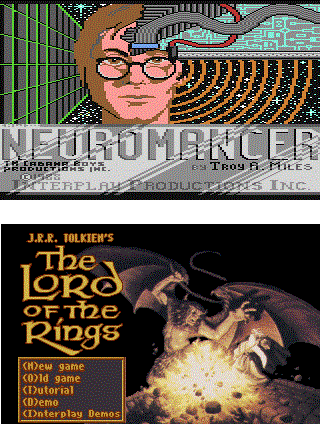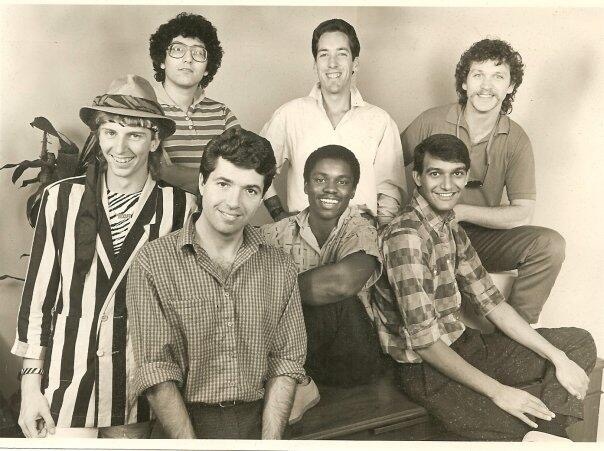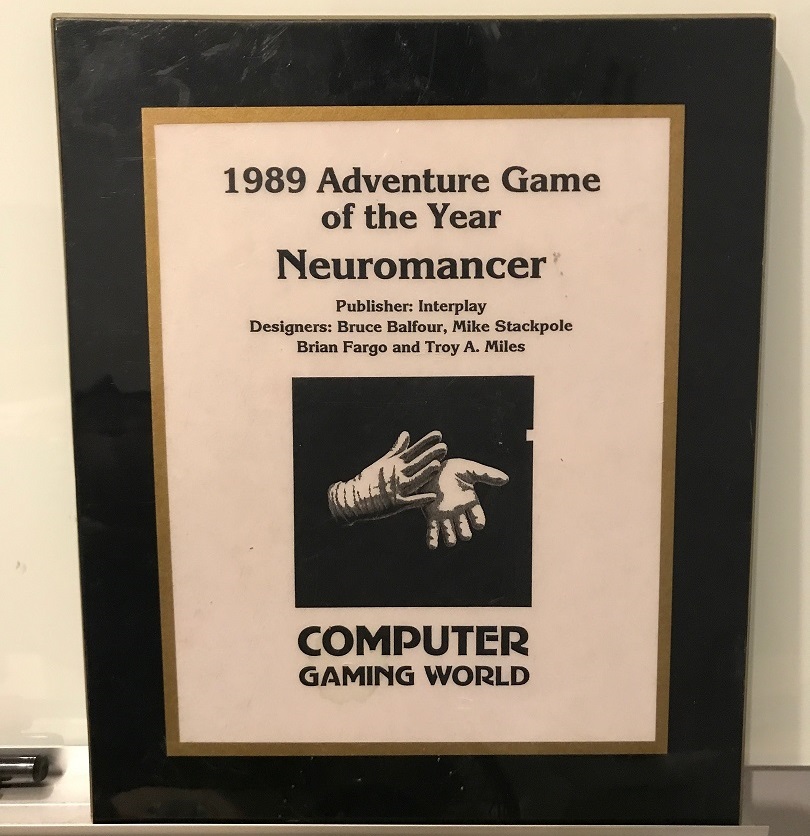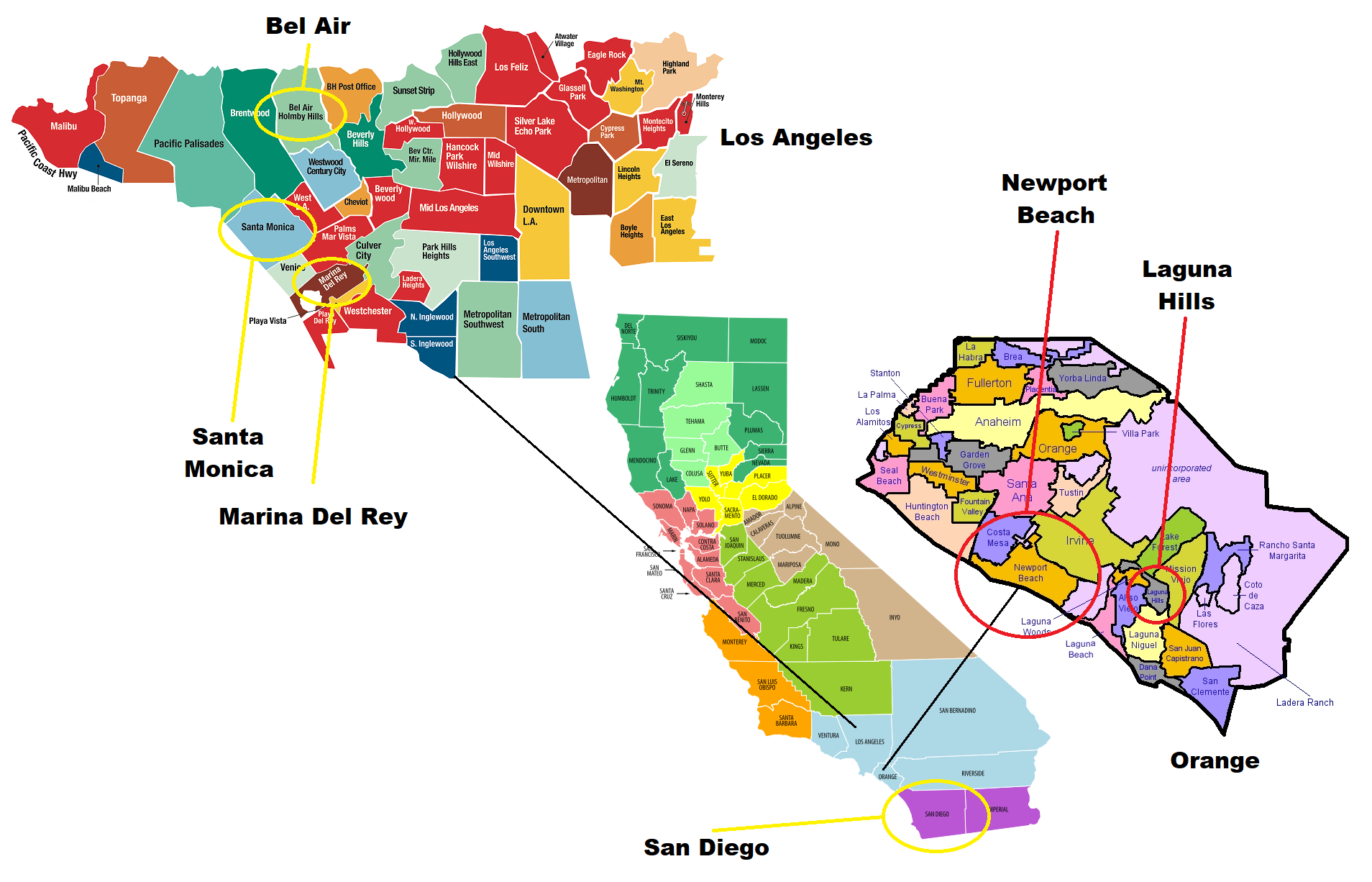Talked to Troy Miles, Neuromant Programmer
 [Troy Miles is a speaker, author, and software developer with years of experience. He began his career with writing games for Commodore 64, Apple II and IBM PC on the 6502th x86th Assembler. Twice winner of the “Game of the Year” award. Author of the book "jQuery Essentials", as well as a large number of journal articles and publications in his own blog. Creator of educational videos. Currently programming web and mobile apps at Kelley Blue Book.]
[Troy Miles is a speaker, author, and software developer with years of experience. He began his career with writing games for Commodore 64, Apple II and IBM PC on the 6502th x86th Assembler. Twice winner of the “Game of the Year” award. Author of the book "jQuery Essentials", as well as a large number of journal articles and publications in his own blog. Creator of educational videos. Currently programming web and mobile apps at Kelley Blue Book.]
Hello! You, probably, know me from the “Reverse Neuromant” series , where I talk about how we reverse-engineer and port a video game based on the novel of the same name by William Gibson . Because of its content, it is rather a spin-off than the next numbering - an independent material that does not require additional preparation from the reader.
It began with viiri , with the words, “This is a programmer who wrote Neuromant. I think he will not mind answering the questions, ” - sent me a link to the twitter account of a person named Troy Miles (in the photo). Then I worked on the fourth part of the cycle and did not attach much importance to it. After thinking about it a few weeks later, the idea of an interview with a developer seemed so successful that I immediately wrote to Troy about who we are, what we do, and what we want from him. The answer did not take long to wait, Troy very favorably responded to our undertaking and agreed to answer my questions.
- Hello, Troy, I think it's time to start our little interview. For starters, I want you to introduce yourself to my readers. Please Troy, tell us about the highlights of your professional career.
- Hello everyone, my name is Troy Miles . I have been working as a programmer since 1979, when I was still in high school. I became the fourth employee hired at Interplay [after it was founded] in 1983. These were great times and great guys. I wrote Neuromanta , Lord of the Rings , and helped with the development of many other games.
 I left Interplay in 1992. I still loved this company, but I needed a stable work schedule. Spent some time at Phoenix Technologies Ltd , working on the system software for PCMCIA modules . Somehow even wrote an article about it in Dr. Dobb's magazine .
I left Interplay in 1992. I still loved this company, but I needed a stable work schedule. Spent some time at Phoenix Technologies Ltd , working on the system software for PCMCIA modules . Somehow even wrote an article about it in Dr. Dobb's magazine .
After Phoenix, I became an independent developer for a while. Made a few contract games for CDI . They were terrible, not in terms of programming - the gameplay was so-so, and the CDI itself , in principle, was not a good idea.
In 2007, I joined the Kelley Blue Book , where I stay today. Our website is www.kbb.com. This is a resource on automotive topics. Without too much gloss, but my colleagues are good enough.
During KBB time, I began to write again and, if possible, hold small conferences. So far, the reports were mostly about jQuery and jQuery Mobile . As a result, I even wrote a book on jQuery and made an instructional video on Ionic . I also made a jQuery Mobile video for Learn Now Online .
Last year, I started shooting videos for LinkedIn Learning / Lynda.com . Today there are 5 of them: two in C ++ , two in Kotlin, and one in Bash . I plan to make some more clips in C ++ in the near future.
In my free time I am developing a mobile game. Nothing extraordinary, ordinary kazualka, which I hope to finish in the first half of 2019. This will be my first game since the mid-nineties CDI .
- Hi Troy, I think that it’s time to start our little interview. Firstly I want to introduce you to my readers. Please, Troy, get us through the milestones of your professional career.
— Hi All, I am Troy Miles. I have been a paid programmer since 1979, while I was still in high school. I was employee number four at Interplay back in 1983. Those were great times and great guys. I wrote Neuromancer, Lord of the Rings, and helped out on a lot of other games.
I left Interplay in 1992. Still loved the company, but needed to work regular hours. Spent sometime at Phoenix Technologies Ltd. Working on PCMCIA system software. Even wrote an article about it for Dr. Dobb's magazine.
After Phoenix I went independent for quite sometime. Did some CDI, compact disc interactive games on contract. They were all terrible. Not because of the programming, but because CDI was not a good idea and the gameplay wasn't very fun.
In 2007, I joined Kelley Blue Book, where I still am today. Our site is [www.kbb.com][www.kbb.com]. It is an automotive valuation site. Not glamorous, but my team mates are smart and fun.
While here at KBB, I started writing again and eventually doing small conferences. For awhile most of talks were on jQuery and jQuery Mobile. I eventually wrote a book on jQuery and did a video on Ionic. I also did a video for Learn Now Online, on jQuery Mobile.
Last year I started doing videos for LinkedIn Learning / Lynda.com. So far I have 5 videos out. Two on C++, two on Kotlin, and one on Bash. I planned to a few more videos on C++ over the next few months.
In my spare time, I have been designing a mobile game. Nothing fancy, a casual game, which I hope to have complete by Q1 or Q2 of 2019. It will be my first game since the CDI era of the mid-90's.
- An impressive track record! But let's go back to 1983, when you first came to Inerplay . Tell us how you got there and who were the great guys you mentioned?
- While in San Diego , about 100 kilometers from Orange , in California , I made my own games for Vic 20 and C64 . In 1983 , an exhibition of computer games was held at a place called Lion Country Safari [Laguna Hills, Orange] . There I met Brian Fargo . He then worked at Boone , headed by a guy named Michael Boone (he later created Boone Boards ). I talked with Boone about getting to them as a game developer, however, when the company fell apart, Briancalled me and offered to join his startup - Interplay Prouctions . I agreed. Our first office was located in the Newport Beach industrial zone , right above the office of clothing manufacturer Quiksilver .

[Photo provided by Troy himself.] In the photo in the front row [from left to right]: Alan Pavlish , Brian Fargo , I , and Jay Patel . Back row: Bill Heinman , Troy Worrell , and Todd Camasta . This is a photograph of the end of 1984 - the beginning of 1985.
In those days we did something under license, contract work and ports for other companies. We even did something for the Ministry of Defense , through Loral . This concerned maps with GPS , which was new at the time. For this work, we received thanks from the US Army. We also worked on a contract with the University of California , Irvine . They made educational games under the guidance of the professor. We also made some adventure action movies for Activison . Among them, MindShadow , Tass Times in Tonetown and Borrowed Time. Spreading games was not easy at the time. Finding a small computer store that would take your game for sale was not very difficult, but it took a lot of time, moreover, without a million dollars in the bank it was simply impossible to force a large distribution network, such as Sears or Walmart , to sell your product. Today it is much easier. You can simply upload your creation to the App Store or sell it yourself through your own website. So getting Activison as a publisher meant a lot and allowed us to stay afloat.
 Around 1987, I created the coolest app that never saw the light. It was called Software Studio . The application allowed you to create something like a cartoon on the C64 and Apple II . Included was a set of prepared scenes and characters. Each character had its own set of animations, they could walk, sit, dance and all that. It used an incredibly effective animation engine - just a few kilobytes you could fit a 5-minute cartoon. At first, Activision became interested in the application , but later they moved away from this topic. Then we tried to interest other players, including Disney . I liked the program, but everyone feared that it was too flexible. In disneyespecially worried about the misuse of their characters. In the end, we admitted defeat and abandoned this venture.
Around 1987, I created the coolest app that never saw the light. It was called Software Studio . The application allowed you to create something like a cartoon on the C64 and Apple II . Included was a set of prepared scenes and characters. Each character had its own set of animations, they could walk, sit, dance and all that. It used an incredibly effective animation engine - just a few kilobytes you could fit a 5-minute cartoon. At first, Activision became interested in the application , but later they moved away from this topic. Then we tried to interest other players, including Disney . I liked the program, but everyone feared that it was too flexible. In disneyespecially worried about the misuse of their characters. In the end, we admitted defeat and abandoned this venture.
After a while, Brian Fargo asked me if I wanted to make a game on Neuromants , on the book we both read. The rights to the film were then, seemingly, in Sabana Boys [Productions] , and they were given the approval of the production. The rights to igronizatsiyu owned Tim Leary , but the development has stalled. Tim is not a programmer, but the coders with whom he worked abandoned the project. We went to Bel-Air [Los Angeles] , 60 kilometers north, to meet him at his house, but that’s another story.
— Quite an impressive track record you have. But let's get back to 1983 when you first came to the Interplay. Tell us more about how did you get there and who were the others you mentioned?
— I had been making my own games for the Vic 20 and C64 in San Diego roughly 100 km from Orange County, both in California. In 1983, there was a computer game expo held at a place called Lion Country Safari. There, I met Brian Fargo. He was working for a company called Boone, which was headed by a guy named, Michael Boone. (He would later go on to create Boone Boards.) I had been talking with Boone about coming on board as a game programmer, but when they collapsed, Brian gave me a call and asked if I wanted to join his startup, Interplay Productions. I said yes. Our original offices were in an industrial section of Newport Beach, above an office the clothing manufacturer, Quiksilver.
In the photo, front row: Alan Pavlish, Brian Fargo, me, and Jay Patel. Back row: Bill Heineman, Troy Worrell, and Todd Camasta. The picture dates to late 1984 or early 1985.
In those days we did titles, contract work, and ports for other companies. We even did some work for the Department of Defense, through Loral. We got a commendation from U.S. Army for our work. It involved moving map with GPS, which was a new thing back then. We also did some contract development for the University of California, Irvine. We made some edutainment games under the direction of a professor. And we did some action adventures games for Activision. They were MindShadow, Tass Times in Tonetown and Borrowed Time, in no particular order. Distributing games was very difficult in those days. Getting small computer stores to carry your game wasn't too difficult, but it was time consuming and it was impossible to get big retailers like Sears and Walmart or chain computer stores to sell your product, unless you had millions of dollars in the bank. Developers today have it much easier. You can just upload to an app store or sell it your self on your own web site. So getting Activision to license our games was a big deal and helped us stay solvent.
During this time, around 1987, I created the coolest app that was never released. It was called Software Studio. It allowed you to make a kind of cartoon on the C64 and Apple II. It came with a collection of pre-built stages and characters. Each character had a collection of animations. They could walk, sit down, dance, etc. The whole thing used an animation engines that was super efficient. In just a kilobytes, you could make a 5 minute cartoon. Initially, Activision was interested, but then they pulled out. Then we tried to interest other players including Disney. Everyone liked the app, but their big concern was the product was too flexible. Disney especially was worried about people making cartoons which inappropriately used their characters. In the end, we admitted defeat and shelved it.
Then, Brian Fargo, asked if I was interested in doing a game based on «Neuromancer». A book we had both read. It seems the Cabana Boys, had the movie rights and it had been green lighted for production. Tim Leary had the computer game rights but the development of the game had stalled. Tim is not a coder and the coders he was working with had abandoned the project. We went to Bel-Air, about 60 km to the north to meet with him at his house and the rest is history.
“A striking story, Troy.” It is a pity that Software Studio has not come out, it seems that it was a serious breakthrough. In childhood I used similar software. I do not remember the name, something like The Simpsons: Cartoon Studio , but according to Soviet cartoons. But it was in the two thousandths, and you did it 15 years ago. Impressive.
But back to business. The next question should have been about how Interplay came to Neuromant , but you have already answered it :). But before we start talking about the game itself, I have a couple of questions, the answers to which are interesting to me personally. That's what's the matter, Timothy Leary is undoubtedly an outstanding person, so what was it like working with him?
And another question, did William Gibson himself take part in the development ?
 Тиимоти Фрэнсис Лири (22.10.1920 — 31.05.1996) — американский писатель, психолог, участник кампании по исследованиям психоделических препаратов, разработчик программного обеспечения.
Тиимоти Фрэнсис Лири (22.10.1920 — 31.05.1996) — американский писатель, психолог, участник кампании по исследованиям психоделических препаратов, разработчик программного обеспечения.
В двадцать лет Лири стал студентом университета Алабамы, а по окончанию получил степень бакалавра психологии. В 1950 стал доктором психологии. В 1957 году создал психодиагностическую методику «тест межличностных отношений Лири», которая до сих пор используется спецслужбами США.
Свою скандальную известность Лири получил за исследование влияния психоделиков на психику и нервную систему человека. Лири активно пропагандировал психоделики, выступал с лекциями и написал ряд книг, посвящённых расширению границ человеческого сознания.
Эта скандальная слава Лири привела к замалчиванию его заслуг в тех областях психологии, которые позже стали ассоциироваться совсем с другими именами.
В 1984 году Лири присоединился к движению киберпанков, которое в те годы захватило Америку. Он и в той среде умудрился стать лидером, собрав вокруг себя недовольных реальностью людей. Вместе с Уильямом Гибсоном учёный пропагандировал воссоединение человека и компьютера, создал несколько программных продуктов, написал ряд книг.
Учёный умер в 1996-ом году. Момент своей смерти он записал на видео, которое было подключено к интернету. Так, за его смертью могли наблюдать все желающие. Последнее, что он сказал, было: «Почему бы и нет?».
- Working with Tim Leary was very cool. He was really cool. Tim invited us to his house to discuss the project. We settled in his living room, from where was just a stunning view of Los Angeles. After a few cans of beer, we told him about our vision of the game, which was very different from his vision. We weren't sure about how he would react, but he liked the idea, and it seemed that he was extremely interested in us putting this into reality.
Funny, Tim , sort of, “grunted” on how active I was. It seemed that before that he had never met an extravert computer programmer. He asked if I was not an actor, I was not, but he just wanted me to star in the film. Then it seemed possible, but, alas, it never came to that. So I missed my chance to become a movie star ;-).
William Gibson did not participate in the development of the game. Although we met once in Santa Monica , during his autograph session. I only had about two minutes to talk to him. We invited him to drink with us after the session, but he already had plans. It seems that he is a cool guy, and I really appreciate that, despite the fact that he was busy, he had a couple of minutes to chat with us.
— Such a stunning story, Troy. Sorry that your Software Studio never released, it seems like it was a serious breakthrough. I remember how I was using similar software when I was a kid. It was something like The Simpsons: Cartoon Studio but adapted for Soviet cartoons, can't remember how it called. But it was in the 2000s, and you already did it 15 years ago. So impressive.
But let's get back to our business. The next question should be about how did the Interplay come up with «Neuromancer», but you already answered it :) Anyway, before we start talking about the actual game, I have a couple of questions which answers is important personally to me. Here we go, there's no doubt that Timothy Leary is an outstanding man, so how it was working with such a person?
And the other question, did William Gibson itself take part in it?
— Tim Leary was super cool to work with. He was genuine nice guy. He invited us to his home to talk about the project. We just all sat in his living room which had a spectacular view of the Los Angeles skyline. We explained to him our vision for the game which was very different from his over a few beers. We weren't really sure how he would react. But he liked our idea and seemed excited for us to make it real.
A weird side note, Tim kind of tripped out on how intense I was. Seems he'd not met an extrovert computer nerd yet. He wanted to know if I was an actor, I'm not, but he really want me to have a part in the movie. At that time, the movie was real, but alas it was never made and there went my chance at stardom ;-).
William Gibson, didn't play any role in the game. We did actually meet once in Santa Monica, where he was doing a book signing. I got about 2 minutes to talk to him. We invited him to drinks or coffee after the signing, but he already had plans. He seemed like a nice guy and I appreciated that he took a few minutes to chat with us even though he was busy.
- I wonder if Gibson played your game? As far as I know, then he was not strong in computers :)
So, "Neuromant" . I know that you were the only programmer on the project. But let's focus on the Neuromant team as a whole. Who else was working on the game? What were the roles?
- As far as I know, Gibson did not play it.
Bruce Belfort was a producer and screenwriter. He was the link that held us together. Very clever and friendly, he was for us something like a mentor. The main screenwriter was Michael Stackpol . Then he was a rising star, and now - the famous author of science fiction. Charles Wademan III was our magnificent artist. He used the tools I had crafted to create the interface, the characters, and their animations. And finally, Brian Fargo , the head of Interplay , served as executive producer and was very involved in the process of creating the game.

[Photos found on the Internet. From left to right: Michael Stakpol, Todd Camasta, Bill Heinman, Troy Miles, Bruce Belfort, Charles Wademan III.]
In total, the game took about 9-10 months. It was stressful, but fun. The coolest thing was how openly and honestly we could talk to each other without taking criticism at our own expense. This allowed us to squeeze the maximum out of each other, which made the game only better.

— Just wondering if Gibson played the game. As far as I know he wasn't much into computers at that time :)
So, the «Neuromancer». I already know that you were a sole programmer on a game, but for now let's focus on the whole Neuromancer team. Who else worked on the game? What was the roles?
— To the best of my knowledge Gibson never played the game.
Bruce Balfour was the producer and a writer. He was the glue that kept us together. Very smart and also amiable. He was kind of like a coach. Michael Stackpole was the main writer for the game. He was a rising star then and has become a well known author of science fiction. Charles H. H. Weidman III was our awesome artist. He was able to use the tools I slapped together to create the UI and the characters, and their animation. And Brian Fargo, the head of Interplay, was the executive producer and was very much involved in the creation of the game.
The game took about a total of 9 or 10 months to make. It was stressful but fun. The best part was how we were able to speak openly and honestly with each other without anyone taking the comments personal. This made the game better and allowed us to get the best out of each other.
- An important point, the game was released on a specific set of platforms, so when you talk about how much time was spent on Neuromant , do you mean some specific version (if so, which one), or all at once? I ask because, for example, the Amiga version [left], compared to the MS-DOS version [middle], looks like a completely different game, not to mention the C64 version [right].

- I am only talking about the C64 . Ports made by other people. The C64 was the coolest car for its money, with a great sound and video chip. The 6502nd processor was also an interesting thing. Due to its simplicity, it allowed to do things that would not allow more powerful processors, such as self-modifying code . Such frills forced to sweat those who made the ports. The game was entirely written in 6502-m Assembler .
— Here is an important point, the game was released on certain set of platforms. So when you talking about how much time it took to make Neuromancer, do you mean one specific version (what is it if so?) or all of them at once? I'm asking because, Amiga [left] version compared with MS-DOS [center] version, for example, looks like completly different game, not to mention C64 [right] version.
— I am only talking about the C64. The ports were done by others. The C64 was an amazing machine for the price. It also had excellent sound and video chips. The 6502 processor was also an interesting beast. Because it was so simple, you could do things that other more powerful CPUs could not, like self-modifying code. These kinds of tricks gave some of the port writers the blues. The entire game was written in 6502 assembly.
- That's cool! Making our port, we assumed that the game was written in Assembler, but did not think that it was originally 6502nd . By the way, about the tricks, maybe you remember and describe a few more?
- Right now, three interesting techniques come to my mind: blasting , interrupts , and self-modifying code .
Blasting . The C64 could have several visible screens, and you could choose which one was active by simply setting a specific value. Using the screen means: clearing it , drawing it , and setting the bit in order to display the result. Obviously, you need the fastest way to clear the screen. And the fastest was the installation of the battery to zero and the sequential recording of the battery value in each cell of the screen. [Troy literally means explicitly writing to each cell:. mov ax, 0; mov screen[0], ax; mov screen[1], ax ... mov screen[n], ax] It looks crazy, and as a programmer, you want to wrap it in a for loop., however, branching critically slows down code execution.
Interruption . Video interruption in C64 started every 30th of a second. It was possible to intercept this interruption and get something like "multitasking for the poor." Whatever you do there - it must be fast, otherwise the picture will twitch. But you could have time to do all sorts of useful things, like sound control or multiplexing sprites.
Self-modifying code . The 6502nd knew how to do one very strange thing - to change the instruction before it was executed. It sounds crazy, but the idea is simple: instead of checking the condition and moving to the next branch of the code, leave one branch and just change its code depending on the condition.
repeat N times {
if STATE is1
increase A by one
else
decrease A by one
do something with A
}
repeat N times {
increase A by one
do something with A
when STATE has to switch {
replace the opcode "increase" above with the opcode to decrease, or vice versa
}
}By the way, at first the PC architecture was extremely poorly suited for gaming. The trouble with the sound, a very simple graphics subsystem, and let's not think about the limitation of 640K memory. Most PCs were then 8088-mi , and they are much slower than their 8086 brethren. So, more memory and a better processor did not make PCs a better development environment.
— Amazing! Making our port we assumed that the game was entirely written in assembly, but never known it was 6502. By the way about the tricks, could you remember and describe some more?
— There were three interesting techniques I can think of right now: blasting, interrupts, and self-modifying code.
Blasting — the C64 can have multiple visible screens and you can change which one is active by setting a value. In order to use a screen you need to clear it, draw it, and then flip the bit to show it. Obviously you want a method to clear the screen as fast as possible. The fastest way possible is to load the accumulator with zero and store the accumulator in each memory address of the screen. It looks crazy and your desire as a coder is to put it a for loop. But the act of branch and checking the branch dramatically slows the code down.
Interrupts — the C64 has a video interrupt every 30th of a second. You can hook into that interrupt to do a bit of a poor man's multi-tasking. Whatever you do must be quick, or the video display will break, but you can do useful stuff like drive the audio or multiplex the sprites.
Self-modifying code — One very weird thing the 6502 can do, is to change an instruction before it is executed. This sounds pointless, but the idea is simple rather than do a compare and a jump to the new code, change the code once you know the choice that needs to made so that subsequent passes don't need to check.
A side note — the original PC architecture was a terrible gaming environment. Sound on the PC was not include, the graphics were very simple, and let's not talk about the 640 K memory issue. Most PCs were 8088 which were slower than their 8086 cousins. So even though the CPU was better and the memory was bigger it didn't make it a better developer environment.
- Indeed, the PC version looks and sounds poorly. However, here is something about the sound. The game soundtrack is based on the song “Some Things Never Change” by Devo . Do you have a story about why this song was chosen, and who, in principle, was responsible for the sound design of the game?
 - I may not be accurate here. As far as I know, Tim Leary and Mark Mathersbo of Devo [pictured] were friends. Somehow, most likely through Tim , we had an intro, and we met up with Mark in his studio in Marina Del Rey . Mark is a cool guy, very savvy in technical matters. We listened to a lot of tracks from the new album Devo , Mark thought that “Some Things Never Change” would be the best for our project, and we were in solidarity with him. Markhanded us a digital copy of the song. Working with sound files in the late 80s is a headache. Bill "Burger" Heinman (now Rebecca Heinman ) was a real wizard, he was able to process the source file and make it 8-bit for C64 and 1-bit for other platforms. That was the first time I heard a real song in a computer game. The sound was not perfect, but good enough for its time.
- I may not be accurate here. As far as I know, Tim Leary and Mark Mathersbo of Devo [pictured] were friends. Somehow, most likely through Tim , we had an intro, and we met up with Mark in his studio in Marina Del Rey . Mark is a cool guy, very savvy in technical matters. We listened to a lot of tracks from the new album Devo , Mark thought that “Some Things Never Change” would be the best for our project, and we were in solidarity with him. Markhanded us a digital copy of the song. Working with sound files in the late 80s is a headache. Bill "Burger" Heinman (now Rebecca Heinman ) was a real wizard, he was able to process the source file and make it 8-bit for C64 and 1-bit for other platforms. That was the first time I heard a real song in a computer game. The sound was not perfect, but good enough for its time.
— Indeed the PC version looks and sounds poor compared to it's brothers. Anyway there is a thing about sound, the game soundtrack based on the song «Some Things Never Change» by Devo. Is there a story about why especially this song was chosen and who was responsible for sound design at all?
— This is a point I am a bit fuzzy on. To the best of my knowledge, Tim Leary was friends with Mark Mothersbaugh of Devo. Somehow we got an intro, most likely via Tim, and met Mark at his studio in Marina del Rey. Mark was a super cool guy. He was also very tech savvy. We listened to a lot tracks on Devo's new album. Mark felt that «Some Things Never Change» would be the best track for our project, and we agreed. He gave us a digital copy of the track on a DAT. It was an immense pain to work with sound files in the late 80's. Burger Bill Heineman, now Rebecca Heineman, was the wizard who processed the file and made it 8 bit on the C64 and 1 bit on all others. It was the first time I had heard an actual song in a computer game. It wasn't perfect but it was cool for its time.
- I think this song fits perfectly. But let's go back to programming and talk a little about the architecture of the game. For Neuromant, did you write a completely new engine or was it based on your previous work?
- Architecturally Neuromant consisted of two parts, animation and gameplay . The animation part, with minimal updates, migrated from Software Studio , which gave the NPC animated reactions and text footnotes. GameplayThe engine was completely new. Initially, it was more difficult, with abundant use of random numbers, but this part was discarded - no one likes too unpredictable games. The game itself had two interesting tools. The first could record the gameplay - the output was a text file. If you feed him a game, she began to play herself. It was for debugging. Also, the game engine was playable by itself, without the animation part. Again, for debugging. The gameplay part of the engine could also work without animation . All this made life easier for the writers, including me, because we could go directly to the right scene and work with it.
— That song suits perfectly in my view. Now let's get back to programming and talk a little about overall game architecture. The first thing, have you written the brand new engine for the Neuromancer or it was based on some of your previous works?
— The architecture of Neuromancer was divided into two parts: animation and game play. The animation survived from Software Studio. It gave all of the NPCs there animated responses and text bubbles. The system was only had a minor update. The game play engine was all new. It had initially been more complicated with more randomness but that part was toned down since no one likes a game that is too random. The game itself had two interesting tools. The first was possible to record the game. Essentially a text file would get output and if you fed that file back into the game it would play itself. It was for debugging. And the game engine was playable by itself without the animation. Again, this was for debugging. The game play could also run without the animation. This made it easier for the writers including myself, since we go directly to the scene we wanted to write or edit.
- I would like to elaborate on the gameplay . Studying the version for MS-DOS, we found out that the game uses something like a virtual machine. The machine executes the bikode contained in files of the form "R% n.BIH" , which, apparently, are scripts for NPC . These files are a nuclear mix of control data, bytecode, object code 8086, and ASCII strings. Are these features of a particular version or part of the original architecture?
“I didn’t work a lot with ports, except that I explained the code for 6502nd to programmers , but it sounds like it’s based on game DAT files . I combined the animation and gameplay in these files, in addition, there was also code for the levels. Don't forget that the 6502nd Assembler had no linker, so I wrote it.
— I want to get a closer look on the gameplay part of this. Exploring the MS-DOS version of the game we found that it utilises a some kind of virtual machine. The Machine executes the bytecode stored in "R%n.BIH" data files, which seems to be an NPC scripts. Those files are crazy mix of control data, the bytecode, some 8086 object code, and ASCII strings. So is it was a part of initial design or it is version specific?
— I didn't do much with the ports except walk the programmer through the 6502 code but it sounds like it is based on the game data files. I combined the animation and the game play together in the data files. There would also be code in it for the levels. Keep in mind that the 6502 assembly didn't have a linker, so I created one.
- Well, since we are working with the port, I have nothing to specifically ask about the code, do you have anything to add? We have already discussed some low-level techniques, but maybe you will recall some interesting problems from working on the game logic?
- In fact, right now I can not remember anything like that. Good luck with the port, and please send me links to the game and the article when they are ready.
— Well, since we work with the port, then I haven't got much to ask about the code. Go on if you have something to add. We already discussed a number of low-level techniques, but maybe you could remember some interesting problems you solved while working on the game logic?
— I don't really have anything else relevant that I can think of right now. Good luck with your port and please send me links to your port and the article when they are ready.
- Of course, Troy. Thank you for your time. Hope you enjoyed this interview. A little question finally: your favorite game?
- The only thing I'm playing now is the X-Plane simulator . She's just great. Sometimes I play on my iPad and I really like games with interesting physics, for example, Hello Stars . It seems to be stupid, but made talent. Sometimes I play copying old-school 8-bit games such as Pitfall and Donkey Kong , but I’m not very far advanced, I simply don’t have enough time for that.
— Yeah, I will. Thanks for your time, Troy. I hope you like the interview. To finish with there is a last little question: what is your favourite game?
— The only game I really play nowadays is a simulation, X-Plane. It is awesome. I occasionally waste time playing games on my iPad and I really like physic based games, like Hello Stars. It is stupid, but clever. I have also been toying with making clones of old school 8 bit games like Pitfall! and Donkey Kong. Neither is very far along, never seem to have enough time.
Such a story. The interview turned out to be small in volume, but, in my opinion, very capacious in terms of details. I published the English version in my blog .
Regarding the game, since the publication of the last article, a lot has been done: dialogue, inventory, saving / loading, and a lot of other things. If everything goes well, then in a couple of weeks we will have quite a playable build, so far without cyberspace, but it will be possible to move a little along the plot. The next number part of the cycle will be released after we get this very build. But now, everything is the same in my blog , you can follow the news on the project.

